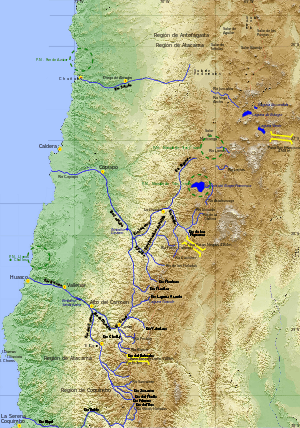Huasco River
Huasco River is a river of Chile located in the Huasco Province, Atacama Region. Its headwaters in the upper catchments in high-altitude Andes glaciers are the Estrecho River, a tributary of El Tránsito River (catchment area 4,135 km2),[2] and Potrerillos River, a tributary of El Carmen River (catchment area 2 890 km2).[2] The Huasco River begins at the confluence of El Tránsito River and El Carmen River which is located in Junta del Carmen (790ma.s.l.).[2] A small portion of its course is impounded by a small dam forming the Embalse Santa Juana.
| Huasco River | |
|---|---|
 Confluence of the Huasco River with the Del Tránsito River (left) and Del Carmen River (right) | |
| Location | |
| Country | Chile |
| Physical characteristics | |
| Source | |
| • location | Del Carmen River and Del Tránsito River |
| Mouth | |
• location | Pacific Ocean |
| Length | 88 km (55 mi)[1] |
| Basin size | 9,850 km2 (3,800 sq mi)[1] |
Cities and towns along the Huasco include: Vallenar, Freirina and Huasco.
Andean glaciers and the Huasco River Basin
The inhabitants of the Huasco valley, a semi-arid region, depend on water resources from the upper catchments in high-altitude Andes glaciers which contribution to the discharge of two Huasco River headwaters: the Estrecho River and the Potrerillos River which arise from two small neighboring catchments, they actually belong to two major subcatchments of the Huasco Basin.[2]
A collaborative study between the Centro de Estudios Avanzados en Zonas Áridas (CEAZA) and the Laboratoire de Glaciologie et Géophysique de l'Environnement (LGGE) investigated the glacier contribution to the Huasco River basins by two glaciated headwater catchments which included the monitoring of five Andean glaciers (Toro 1, Toro 2, Esperanza, Guanaco, Estrecho and Ortigas) between 2003/2004 and 2007/2008 hydrological years. The Andean "glaciers accelerated retreat" represents a "striking example of climate change impacts."[2]
Concerns were raised by Sustainable Chile Program president, Sara Larraín, a Chilean politician and environmentalist who ran for president in 1999 presidential election, that the Andean glaciers, particularly Toro 1, Toro 2 and Esperanza, were endangered by the Pascua Lama project.[3]
In May 2013, Chile's Superintendence of the Environment Superintendencia del Medio Ambiente (SMA) notified Barrick Gold that the company had to cease construction activities at Pascua-Lama until they complete water management system in accordance with the project's environmental permit. Barrick Gold was also fined approximately $16 million for noncompliance regarding the project's water management system.[4]
See also
References
- "Cuenca del Río Huasco, Dirección General de Aguas, Ministerio de Obras Públicas, Gobierno de Chile" (PDF). Archived from the original (PDF) on 2012-02-12. Retrieved 2007-08-14.
- S. Gascoin; C. Kinnard; R. Ponce; et al. (2011). "Glacier contribution to streamflow in two headwaters of the Huasco River, Dry Andes of Chile" (PDF). The Cryosphere. Copernicus Publications on behalf of the European Geosciences Union. 5: 1099–1113. doi:10.5194/tc-5-1099-2011.
- Baldini, Luisa (2 January 2007). "Chile's divisive mountain of gold". Chile: BBC News.
- "Barrick to Assess Implications of SMA Resolution". Barrick Gold. 24 May 2013.
